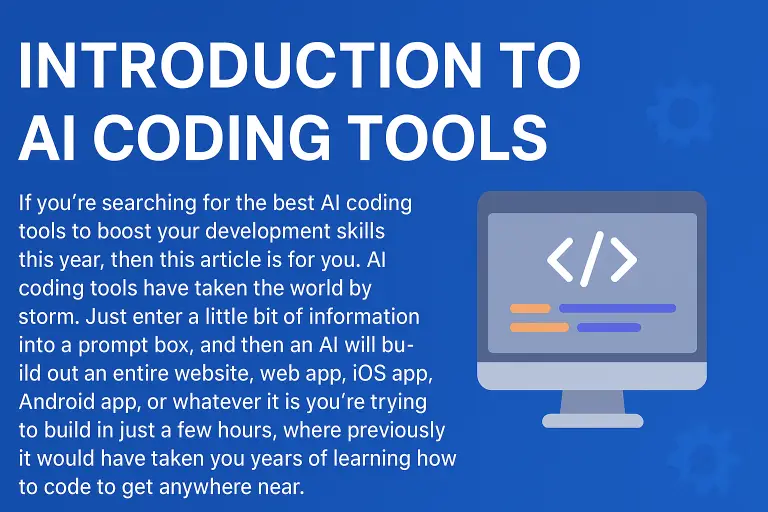Table of Contents

Introduction to AI coding tools
If you’re searching for the best AI coding tools to boost your development skills this year, then this Article is for you. AI coding tools have taken the world by storm. Just enter a little bit of information into a prompt box, and then an AI will build out an entire website, web app, iOS app, Android app, or whatever it is you’re trying to build in just a few hours, where previously it would have taken you years of learning how to code to get anywhere near.
The problem is that with AI moving so quickly and with so many AI coding tools popping up almost every single week, it can be completely impossible to stay upto-date and figure out which is the best one for you and your specific needs. Luckily, over the last couple of months, I’ve been diving into every single AI coding tool out there, as well as all of the different and new AI coding models. And in this Article, I’ve broken each of them down, looking at things like price, ease to start, and most importantly, the actual output at the end.
1. Cursor AI
Cursor is one of my favorites. It starts at just 20 bucks a month, and you can also go through the free trial, which is free for a couple of weeks. It’s well worth checking out and jumping into right now. One of the interesting things about cursor is that it’s actually a fork of VS Code. If you’re not familiar with VS Code, this is the platform that most developers would use when they were self-coding manually before the dawn of AI.
Now, this is important because it’s got all of the original functionality of VS Code plus Cursor AI automation on top of it. Also importantly here and one of the standout things of cursor over the other tools on today’s list.
This is actually an app that sits on your desktop rather than you using it in a browser. This allows it to be slightly more powerful and in my experience it allows for a little bit more customization and ease of use.
How to get started with Cursor?
Now to get started with Cursor, you just head over to their website, sign up to the trial, download their platform for Mac or Windows, and then you can jump straight in. You can select any of a number of different models, including some of the best ones like Sonet 3.7, Gemini 2.5 Pro, and the latest from OpenAI. And you can also set up some customizations here as well, such as giving Cursor some constraints over the languages you want to use.
Then it really is as simple as creating a new folder and then prompting Cursor agent on what you want to build, whether that’s a landing page, a more complex app, or even an iOS app if you want. You then need to work through this conversationally and get it to pick up any bugs that you can then just copy and paste back into Cursor and get it to solve them like a junior developer.
Now, in my experience of using Cursor, it’s a little bit more challenging to get started with if you don’t have any coding background. Remember, I can actually do a little bit of coding. Although I wouldn’t say I’m a proper coding developer, but I know some of the basics and I can figure my way around a lot of the common languages like Nex.js, Ruby, bunch of others as well.
If you have got some familiarity, it’s pretty amazing cuz it’s going to save you a lot of time.
If you’re right at the beginning of your coding journey, some of the others which are browser based on this list are going to have a little bit of a lower learning curve and allow you to get started a little bit more quickly. One of the other drawbacks is you do have to use some of the command line interfaces if you want to test your product.
So, you need to host things locally, which lots of developers will be familiar with. But if you’re just starting off, this might be quite daunting, and you might just want a solution that shows you what you’re building immediately, like Claude 3.7 can do on the main Claude website. That being said, it’s pretty cost- effective. It’s pretty great, and I’ve built a ton of stuff with it in just the last few weeks alone.
2. Google’s Firebase Studio
Google’s Firebase Studio, which caters to advanced programmers with a robust set of features that streamline the development process. It uses AI agents to allow users to transition from browser access to application development in minutes. The platform supports the import of various different repositories, making it really versatile for different tech stacks.
The downside here is that it does struggle with some basic tasks like regular expressions, which might be limiting for some users. Firebase Studios customizable development environments via Nyx and flexible deployment options make it really powerful for serious developers, but again, perhaps a little complex if you’re just starting out.
Firebase, if you’re not familiar with, is one of Google’s main coding platforms, and it also allows you to deploy and is used in a ton of different web and mobile applications. When I jumped into it, it’s kind of Google ecosystem is great.
It’s currently, at the time of writing this Article, completely free, which makes the price really compatible, too. And it plugs into Google’s Gemini, which is a great coding model, as we’ll see later on. That being said, some of the outputs weren’t quite as good as I was expecting, and it didn’t quite understand and do exactly what I wanted, which is possibly to do with the reliance on Gemini, but it’s definitely worth checking out if you’re a mid to advanced level programmer.
3. Windsurf
Windsurf, which used to be known as Kodium, which is really tailored for our SAS enterprise applications, focusing on security and change management and analytics. It comes with both free and paid versions with paid starting around $20 a month. And it’s got really powerful code completion and refactoring assistance, making it really valuable for maintaining high standards of code and
security.
In my opinion, Windsurf is up there with cursor in terms of what it can do and its reliability of outputs. A little bit like cursor, you can select from many different models and then code within the application window, but with one big advantage being that you can see the output code actually rendered in real time, making it a little bit faster and a little bit more accessible than tools like Cursor that require you to build locally.
4. Bolt
Bolt, which is really great if you’re a Mac user where it’s fully optimized. It integrates seamlessly with other development environments, allowing us to interact with AI directly from our coding environment. This minimizes things like context switching and enhancing our workflows.
And it allows for the creation of custom AI tool assistance tailored to specific tasks, adding versatility for our various professional settings. It does require us to code online in the browser.
And if you’re a Windows user, it might not be that accessible right now. In my experience, the integration into existing coding tools is really good and it’s quite simple to get started with with a simple large prompting window where you can build out a multitude of different ideas from. The price is really competitive and again it can plug into a range of different AI models allowing for different outputs. The UX is also really nice here and the speed of actual AI rendering of the code is really really fast.
I’d say that Bolt and Cursor are probably the fastest tools that I’ve tested on this list with Bolt maybe with its latest release just edging it. Again, definitely worth checking out and jumping into and something that you can get started with pretty quickly without needing to download anything.
5. Replit
Replit, which has been around for a little while and covers the full lifespan of going from code to actually deployment and testing and optimizing our apps. Replit supports the creation and development of websites, automations, internal tools, and data pipelines in pretty much any programming language you can think of.
It’s super easy to use and get started with, but if you do want some deeper coding abilities, you’re going to miss out because it’s only web- based at the moment. I found Replit to be a little bit less visually appealing than tools like Bolt or Cursor on this list, and it’s also a little bit slower, but it does have a competitive price point starting at $25 a month for the paid version.
Because it’s got that deployment built in, if you’re not familiar with tools like either Superbase or Vel for deploying your code to, then it might be a really great place to start and there have been lots of really big app on Replet before moving on to other hosts in the future. So again, we know it’s accessible for earlystage businesses.
6. Lovable
Lovable, this is also one of my favorites and it comes from the Nordics. It’s one of my favorites because it’s so simple. It’s got a really minimal interface and you can have minimal coding knowledge to get started. It allows for fast prototyping. It’s got built-in deployment, but because of this, it does have limited customization, and if you’re an experienced developer, it might not be quite up to scratch.
It uses popular coding libraries like React, Vue, and Angular. And it chooses the appropriate tool based on your app requirements and its own internal huristics. The generated UI code is clean, modular, and follows industry best practices. and it also includes common interface elements like forms, buttons, display components, and more, making it really, really easy to get started with. It also comes in at around about $20 a month starting. So, it’s well worth checking out and trying if you’re just at the beginning of your development journey.
7. V0ero
I just want to touch on this list is V0ero by Vel. Now, this is a little bit different to the others because it focuses on web development and the front-end UI. If you’re looking for a landing page generator, it’s from Vel who focus on deployment. And it’s a really great way to just type in a couple of quick lines and then get a full-blown landing page out that you can then work in the conversation window to actually optimize around what you want.
It’s a really fun way to get started and it’s also got a library of UI components that you can potentially pull into your bigger coding tool like a wind surf or a cursor and use that. It’s pretty accessible to get started with and it’s cheap and it’s really worth checking out.
Conclusion
AI coding tools let you build faster, smarter, and with less effort. Choose the right one for your needs—and turn your ideas into reality in no time.
